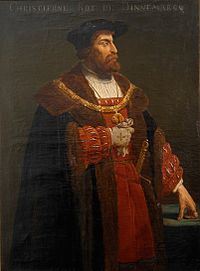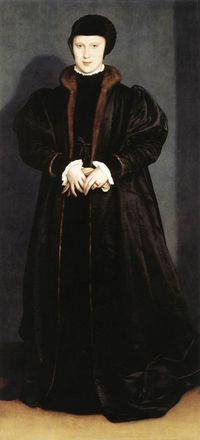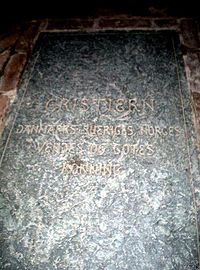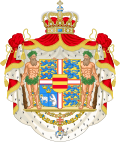- Christian II of Denmark
-
Christian II 
King of Denmark and Norway Reign 22 July 1513 – 20 January 1523 Coronation 11 June 1514 (Denmark)
20 July 1514 (Norway)Predecessor John Successor Frederick I King of Sweden Reign 1 November 1520 – 23 August 1521 Coronation 4 November 1520 Predecessor John II Successor Gustav I Spouse Isabella of Austria Issue Christina, Duchess of Milan
Dorothea, Electress PalatineHouse House of Oldenburg Father John, King of Denmark Mother Christina of Saxony Born 1 July 1481
Nyborg CastleDied 25 January 1559 (aged 77)
Kalundborg castleBurial Odense Signature 
Religion Roman Catholicism Christian II (1 July 1481 – 25 January 1559) was King of Denmark, Norway (1513–23) and Sweden (1520–21), during the Kalmar Union.
Contents
Background
Christian was born as the son of King John of Denmark and Christina of Saxony, at Nyborg Castle in 1481 and succeeded his father as king and regent in Denmark and Norway, where he later was to be succeeded by his uncle King Frederick I of Denmark.[1]
Christian descended, through both Valdemar I of Sweden and Magnus I of Sweden, from the Swedish Dynasty of Eric, and from Catherine, daughter of Inge I of Sweden, as well as from Ingrid Ylva, granddaughter of Sverker I of Sweden. His rival Gustav I of Sweden descended only from Sverker II of Sweden and the Dynasty of Sverker (who apparently did not descend from ancient Swedish kings).
Biography
Christian took part in his father John of Denmark's conquest of Sweden in 1497 and in the fighting of 1501 when Sweden revolted. He was appointed viceroy of Norway in 1506, and succeeded in maintaining control of this country. During his administration in Norway,[2] he attempted to deprive the Norwegian nobility of its traditional influence exercised through the Rigsraadet privy council, leading to controversy with the latter.[citation needed]
Christian's succession to the throne was confirmed at the Herredag assembly of notables from the three northern kingdoms, which met at Copenhagen in 1513. The Swedish delegates said, "We have the choice between peace at home and strife here, or peace here and civil war at home, and we prefer the former." A decision as to the Swedish succession was therefore postponed.[3]
During his reign, Christian concentrated on his attempts to maintain control of Sweden while attempting a concentration of power in the hands of the monarch, at the expense of both clergy and nobility.[citation needed] To further this attempt, he supported the creation of a strong class of burghers.[2]
Personal life
A peculiarity, more fatal to him in that aristocratic age than any other, was his fondness for the common people, which was increased by his passion for a pretty Norwegian girl of Dutch heritage, named Dyveke Sigbritsdatter, who became his mistress in 1507 or 1509. On 12 August 1515, Christian married Isabella of Austria, the granddaughter of Holy Roman Emperor Maximilian I. But he would not give up his liaison with Dyveke, and it was only her death in 1517, under suspicious circumstances, that prevented serious complications with the emperor Charles V.[3].
Christian believed that the magnate Torben Oxe was guilty of Sigbritsdatter's death and despite his having been acquitted of murder charges by Rigsraadet and had him executed. Oxe was brought to trial at Solbjerg outside Copenhagen in what amounted to a justice-of-the-peace court on vague offenses against his liege lord, Christian II. The verdict as directed by the king was guilty and the death sentence imposed with the comment, 'your deeds not your words have condemned you'. Over the strenuous opposition of Oxe's fellow peers he was executed at St. Clare's Hosptial Cemetery in late 1517.[citation needed] Thereafter the king lost no opportunity to suppress the nobility and raise commoners to power.[3]
His chief counsellor was Dyveke's mother Sigbrit Willoms, who excelled in administrative and commercial affairs. Christian first appointed her controller of the Sound Dues of Øresund, and ultimately committed to her the whole charge of the finances. A bourgeoise herself, it was Sigbrit's constant policy to elevate and extend the influence of the middle classes. She soon formed a middle-class inner council centering on her, which competed for power with Rigsraadet itself. The patricians naturally resented their supersession and nearly every unpopular measure was attributed to the influence of "the foul-mouthed Dutch sorceress who hath bewitched the king."[3] However, Mogens Gøye, the leading man of the Council, supported the king as long as possible.[citation needed]
Reconquest of Sweden
Christian was meanwhile preparing for the inevitable war with Sweden, where the patriotic party, headed by the freely elected Viceroy Sten Sture the Younger, stood face to face with the pro-Danish party under Archbishop Gustav Trolle. Christian, who had already taken measures to isolate Sweden politically, hastened to the relief of the archbishop, who was beleaguered in his fortress of Stäket, but was defeated by Sture and his peasant levies at Vedila and forced to return to Denmark. A second attempt to subdue Sweden in 1518 was also frustrated by Sture's victory at Brännkyrka.[3]
A third attempt made in 1520 with a large army of French, German and Scottish mercenaries proved successful. Sture was mortally wounded at the Battle of Bogesund, on 19 January, and the Danish army, unopposed, was approaching Uppsala, where the members of the Swedish Privy Council, or Riksråd, had already assembled. The councillors consented to render homage to Christian on condition that he gave a full indemnity for the past and a guarantee that Sweden should be ruled according to Swedish laws and custom; and a convention to this effect was confirmed by the king and the Danish Privy Council on 31 March.[3]
Sture's widow, Dame Christina Gyllenstierna, still held out stoutly at Stockholm, and the peasantry of central Sweden, roused by her patriotism, flew to arms, defeated the Danish invaders at Balundsås on 19 March, and were only with the utmost difficulty finally defeated at the bloody battle of Uppsala, on Good Friday, 6 April 1520. In May the Danish fleet arrived, and Stockholm was invested by land and sea; but Dame Gyllenstierna resisted valiantly for four months longer and took care, when she surrendered on 7 September, to exact beforehand an amnesty of the most explicit and absolute character. On 1 November, the representatives of the nation swore fealty to Christian as hereditary king of Sweden, though the law of the land distinctly provided that the Swedish crown should be an elective monarchy.[3]
Stockholm Bloodbath
On 4 November, Christian was anointed by Gustav Trolle in Stockholm Cathedral, and took the usual oath to rule the Realm of Sweden through native-born Swedes alone, according to prescription. The next three days were given up to banqueting, but on 7 November "an entertainment of another sort began." On the evening of that day Christian summoned his captains to a private conference at the palace, the result of which was quickly apparent, for at dusk a band of Danish soldiers, with lanterns and torches, broke into the great hall and carried off several carefully selected persons.[3]
By 10 o'clock the same evening the remainder of the king's guests were safely under lock and key. All these persons had previously been marked down on Archbishop Trolle's proscription list. On the following day a council, presided over by Trolle, solemnly pronounced judgment of death on the proscribed, as manifest heretics. At 12 o'clock that night the patriotic bishops of Skara and Strängnäs were led out into the great square and beheaded. Fourteen noblemen, three burgomasters, fourteen town councillors and about twenty common citizens of Stockholm were then drowned or decapitated. The executions continued throughout the following day; in all, about eighty-two people are said to have been murdered.[3]
Moreover, Christian ordered that Sten Sture's body should be dug up and burnt, as well as the body of his little child. Dame Christina and many other noble Swedish ladies were sent as prisoners to Denmark. When it became necessary to make excuses for the massacre, Christian proclaimed to the Swedish people that it was a measure necessary to avoid a papal interdict, while in his apology to the pope for the decapitation of the innocent bishops he described it as an unauthorized act of vengeance on the part of his own people.[3] The massacre and deeds in the Old Town of Stockholm is the primary reason why Christian is remembered in Sweden, as Christian the Tyrant (Kristian Tyrann).[citation needed]
Attempting reforms
Christian II returned to his native kingdom of Denmark, his brain teeming with great designs. There can be no doubt that the welfare of his dominions was dear to him. Inhuman as he could be in his wrath, in principle he was as much a humanist as any of his most enlightened contemporaries. But he would do things his own way; and deeply distrusting the Danish nobles with whom he shared his powers, he sought help from the wealthy and practical middle classes of Flanders. In June 1521, he paid a sudden visit to the Low Countries, and remained there for some months. He visited most of the large cities, took into his service many Flemish artisans, and made the personal acquaintance of Quentin Matsys and Albrecht Dürer; the latter painted his portrait. Christian also entertained Erasmus, with whom he discussed the Protestant Reformation, and let fall the characteristic expression: "Mild measures are of no use; the remedies that give the whole body a good shaking are the best and surest."[3]
Never had King Christian seemed so powerful as upon his return to Denmark on 5 September 1521, and, with the confidence of strength, he at once proceeded recklessly to inaugurate the most sweeping reforms. Soon after his return he issued his great Landelove, or Code of Laws. For the most part this is founded on Dutch models, and testifies in a high degree to the king's progressive aims. Provision was made for the better education of the lower, and the restriction of the political influence of the higher clergy; there were stern prohibitions against wreckers and "the evil and unchristian practice of selling peasants as if they were brute beasts"; the old trade guilds were retained, but the rules of admittance thereto made easier, and trade combinations of the richer burghers, to the detriment of the smaller tradesmen, were sternly forbidden.[3]
Downfall
Unfortunately these reforms, excellent in themselves, suggested the standpoint not of an elected ruler, but of a monarch by divine right. Some of them were even in direct contravention of the charter; and the old Scandinavian spirit of independence was deeply wounded by the preference given to the Dutch. Sweden, too, was now in open revolt; and both Norway and Denmark were taxed to the utmost to raise an army for the subjection of their sister kingdom. Foreign complications were now added to these domestic troubles. With the laudable objective of releasing Danish trade from the grinding yoke of the Hanseatic League, and making Copenhagen the great emporium of the north, Christian had arbitrarily raised the Sound tolls and seized a number of Dutch ships that presumed to evade the tax. Thus, his relations with the Netherlands were strained, while he was openly at war with Lübeck and her allies.[3]
Jutland finally rose against him, renounced its allegiance, and offered the Danish crown to Christian's uncle, Duke Frederick of Holstein, 20 January 1523. So overwhelming did Christian's difficulties appear that he took ship to seek help abroad, and on 1 May landed at Veere in Zeeland.[3] During the years of his exile, the king led a relatively humble life in the city of Lier in the Netherlands, waiting for the military help of his reluctant imperial brother-in-law. In the meantime, he became regarded a social saviour in Denmark, where both the peasants and the commoners began to wish for his restoration. He found consolation in his distress to enter in connection with Martin Luther and for some time, he even became a a Lutheran. Christian and his wife lived next Lier, in Brabant, where Elizabeth died in January 1526, after which the children were taken away from Christian to not be raised as heretics. But when both his opponent, Frederick I, and Gustav Vasa, who joined the Reformation, became Lutherans in 1530 Christian reconverted to Roman Catholic Church and thus reconciled with the Emperor.[citation needed] Eight years later, on 24 October 1531, he attempted to recover his kingdoms, but a tempest scattered his fleet off the Norwegian coast, and on 1 July 1532, by the convention of Oslo, he surrendered to his rival, King Frederick,[3] in exchange for a promise of safe conduct.[citation needed]
But King Frederick did not keep his promise, and King Christian was kept prisoner for the next 27 years, first in Sønderborg Castle until 1549, and afterwards at the castle of Kalundborg. Stories of solitary confinement in small dark chambers are inaccurate; King Christian was treated like a nobleman, particularly in his old age, and he was allowed to host parties, go hunting, and wander freely as long as he did not go beyond the boundaries of the town of Kalundborg. His cousin, King Christian III of Denmark, son of Frederick I, died in early 1559, and it was said that even then, with the old king nearing 80, people in Copenhagen looked warily towards Kalundborg. But King Christian II died peacefully just a few days later, and the new king, Frederick II, ordered that a royal funeral be held in memory of his unhappy kinsman, who lies buried in Odense next to his wife, son and parents.[citation needed]
Legacy
Christian II is one of the most discussed of all Danish kings. He has been regarded as both a hypocritical tyrant and a progressive despot, who wanted to create an absolute monarchy based upon “free citizens”. His psychological weaknesses have caught the interest of historians, especially his frequently mentioned irresolution, which as years passed seemed to dominate his acts. Theories of manic-depression have been mentioned, but like many others they are impossible to prove. The reasons for his downfall were probably that he made too many enemies and that the Danish middle class was still not strong enough to make up a base of royal power. However some of his ambitions were fulfilled by the victory of absolutism in 1660.
The king’s life and career have created many myths. One of the most famous is the story of the irresolute king crossing the Little Belt forwards and backwards during a whole night in February 1523, until he at last gave up. Another, probably just as unlikely, is the legend that the restless king wandered around a round table on Sønderborg making a groove in the table top with his finger. His life has also inspired modern Danish poets and authors. In Johannes Vilhelm Jensen's novel The Fall of the King (1900–1901), the king is regarded almost as a symbol of the Danish “illness of hesitation”.
Issue
Among the six children of Christian II, three must be mentioned. Prince John died as a boy in exile in 1532. The two daughters Dorothea, Electress Palatine, and Christina, Duchess of Lorraine, both in turn, for many years, demanded in vain the Danish and Norwegian thrones as their inheritance. Christian II's blood returned to the Swedish and Norwegian thrones in person of Charles XV of Sweden, descendant of Renata of Lorraine.
By his wife, Isabella of Austria (1501–1526)
Name Birth Death Notes John 21 February 1518 1532 Philip Ferdinand (twin) 4 July 1519 1520 Maximilian (twin) 4 July 1519 1519 Dorothea 10 November 1520 31 May 1580 married in 1535, Frederick II, Elector Palatine and had no issue. Christina c.1522 c.1590 married in 1533, Francis II Sforza and had no issue, married secondly in 1541, Francis I, Duke of Lorraine and had issue. stillborn son January 1523 January 1523 Ancestry
Ancestors of Christian II of Denmark 16. Christian V, Count of Oldenburg 8. Theodoric, Count of Oldenburg 17. Agnes von Honstein 4. Christian I of Denmark 18. Gerhard VI of Holstein-Rendsburg, Duke of Schleswig 9. Helvig of Schauenburg 19. Elisabeth of Brunswick 2. John of Denmark 20. Frederick I, Elector of Brandenburg 10. John, Margrave of Brandenburg-Kulmbach 21. Elisabeth of Bavaria 5. Dorothea of Brandenburg 22. Rudolph III, Duke of Saxe-Wittenberg 11. Barbara of Saxe-Wittenberg 23. Anna of Thuringia 1. Christian II of Denmark 24. Frederick I, Elector of Saxony 12. Frederick II, Elector of Saxony 25. Catherine of Brunswick 6. Ernest, Elector of Saxony 26. Ernest, Duke of Austria 13. Margaret of Austria 27. Cymburgis of Masovia 3. Christina of Saxony 28. Ernest, Duke of Bavaria 14. Albert III, Duke of Bavaria 29. Elisabetta Visconti 7. Elisabeth of Bavaria 30. Eric I, Duke of Brunswick-Grubenhagen 15. Anna of Brunswick-Grubenhagen-Einbeck 31. Elisabeth of Brunswick-Göttingen References
- ^ (in Danish) Historie, Stockholm: Royal Danish Embassy, http://www.ambstockholm.um.dk/da/menu/OmSverige/Historie/.
- ^ a b Store Danske Encyklopædi, entries "Hans" and "Christian 2.", Copenhagen: Gyldendal (Danish)
- ^ a b c d e f g h i j k l m n o Encyclopædia Britannica, Eleventh Edition, 1911, "Christian II"
Christian IIBorn: 2 July 1481 Died: 25 January 1559Regnal titles Preceded by
JohnKing of Denmark and Norway
1513–1523Succeeded by
Frederick IDuke of Holstein and Schleswig
1513-1523
with Frederick ISucceeded by
Frederick I
and Christian IIIVacant Title last held byJohn IIKing of Sweden
1520–1521Vacant Title next held byGustav IMonarchs of Norway Fairhair dynasty · rival
rulers of other housesHarald I Fairhair · Eric Bloodaxe · Haakon I the Good · Harald II Greycloak · Haakon Sigurdsson 1 · Olaf I Tryggvason · Eiríkr Hákonarson 1 & Sveinn Hákonarson 1 & Hákon Eiríksson 1 · Sweyn Forkbeard · Olaf II the Saint · Hákon Eiríksson 1 · Canute the Great · Sveinn Álfífuson 1 · Magnus I the Good · Harald III Hardrada · Magnus II Haraldsson · Olaf III Kyrre · Haakon Magnusson & Magnus III Barefoot · Olaf Magnusson · Eystein I Magnusson · Sigurd I the Crusader · Magnus IV the Blind · Harald IV Gille · Sigurd the Noisy · Sigurd II Munn · Eystein II Haraldsson · Inge I Haraldsson the Hunchback · Haakon II Broadshoulder · Magnus Erlingsson · Sigurd Markusfostre · Olav the Unlucky · Eystein the Maiden · Sverre Sigurdsson · Jon Kuvlung · Sigurd Magnusson · Inge Magnusson · Haakon III Sverresson · Guttorm Sigurdsson · Inge II Bårdsson · Erling Stonewall · Philip Simonsson · Haakon IV Haakonsson · Haakon the Young · Magnus VI the Law-mender · Eric II Magnusson · Haakon V MagnussonKnýtlinga 985–995
1028–1035Fairhair dynasty · Sweyn Forkbeard 5 · Fairhair dynasty · Canute the Great 5 · Sweyn Knutsson 2 Fairhair dynastyBjelbo 1319–1387The Kalmar union 1387–1448Oldenburg 1448–1814Christian I 4 · John 4 · Christian II 4 · Frederick I 2 · Christian III 2 · Frederick II 2 · Christian IV 2 · Frederick III 2 · Christian V 2 · Frederick IV 2 · Christian VI 2 · Frederick V 2 · Christian VII 2 · Frederick VI 2 · Christian FrederickHolstein-Gottorp
Bernadotte1814–1905Schleswig-Holstein-
Sonderburg-Glücksburgsince 19051 Regent. 2 Also Danish monarch. 3 Also Swedish monarch. 4 Also Danish and Swedish monarch.5 Also Danish and English monarch. Monarchs of Sweden Munsö Stenkil c.1060–c.1130
1160–1161Stenkil (Stænkil) · Eric Stenkilsson / Eric the Pagan · Halsten · Anund Gårdske · Håkan the Red · Halsten / Inge the Elder · Blot-Sweyn · Inge the Elder · Philip Halstensson / Inge the Younger · Ragnvald Knaphövde · Magnus the Strong · Houses of Sverker and Eric · Magnus HenriksenSverker · Eric c.1130–1250Sverker the Elder · Eric the Saint · Magnus Henriksen · Charles Sverkersson · Kol / Boleslas · Canute I · Sverker the Younger · Eric Canutesson · John Sverkersson · Eric Ericsson · Canute II 1 · Eric EricssonBjelbo 1250–1364Valdemar Birgersson · Magnus Ladulås · Birger Magnusson · Mats Kettilmundsson 2 · Magnus Ericsson3 · Eric Magnusson · Magnus Ericsson / Haakon Magnusson3Mecklenburg 1364–1389AlbertKalmar Union Italics indicate
regents1389–1523Margaret I of Denmark4 / Eric of Pomerania4 · Engelbrekt Engelbrektsson · Eric of Pomerania4 · Charles Canutesson · Eric of Pomerania4 · Charles Canutesson · Christopher of Bavaria4 · Bengt Jönsson (Oxenstierna) / Nils Jönsson (Oxenstierna) · Charles Canutesson3 · Jöns Bengtsson Oxenstierna / Erik Axelsson Tott · Christian I4 · Kettil Karlsson (Vasa) · Charles Canutesson · Kettil Karlsson (Vasa) · Jöns Bengtsson Oxenstierna · Erik Axelsson Tott · Charles Canutesson · Sten Sture the Elder · John II4 · Sten Sture the Elder · Svante Nilsson · Eric Trolle · Sten Sture the Younger · Christian II4 · Gustaf Eriksson (Vasa)Vasa 1523–1654Palatinate-
Zweibrücken
Hesse-Kassel1654–1751Holstein-Gottorp 1751–1818Bernadotte since 1818Charles XIV John3 · Oscar I3 · Charles XV3 · Oscar II3 · Gustaf V · Gustaf VI Adolf · Carl XVI Gustaf1 Lineage uncertain. 2 Regent. 3 Also Norwegian monarch. 4 Also Norwegian and Danish monarch. 5 Also king of Poland. Categories:- 1481 births
- 1559 deaths
- Danish monarchs
- Norwegian monarchs
- Swedish monarchs
- Roman Catholic monarchs
- Converts to Protestantism from Roman Catholicism
- Converts to Roman Catholicism from Lutheranism
- Rulers of Finland
- Kalmar Union
- Dukes of Schleswig
- Dukes of Holstein
- House of Oldenburg
- Knights of the Golden Fleece
- Burials at St. Canute's Cathedral
- Swedish monarchs of German descent
Wikimedia Foundation. 2010.





